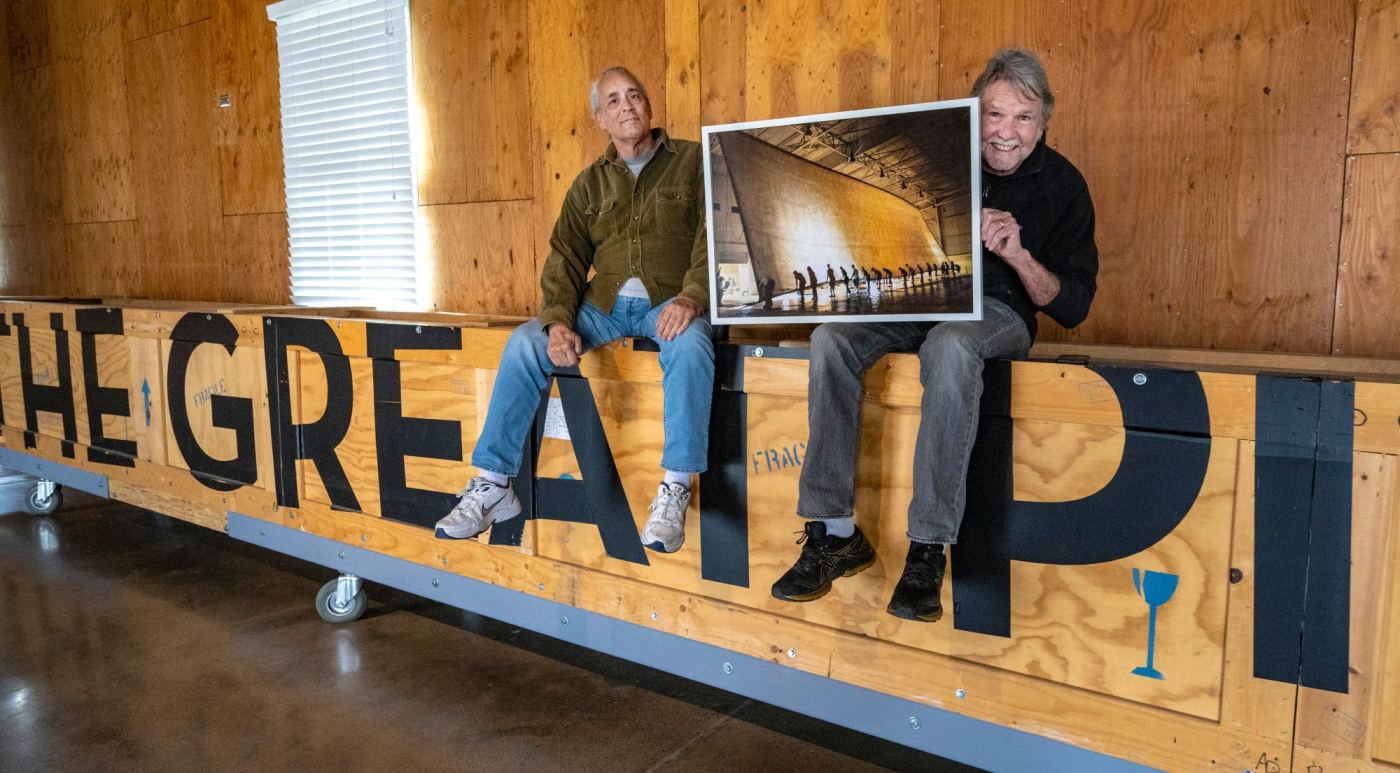The world’s largest photograph taken by the largest camera happened in Irvine. And starting this weekend, the Great Park will expose visitors to what went into creating the 31-by-111-foot image.
The Great Park Artists Studios will open the new exhibit, “The Great Picture: Making the World’s Largest Photograph,” on Sunday, Feb. 19.
“The Great Picture,” was created in Irvine by six photographers with The Legacy Project: Jerry Burchfield, Mark Chamberlain, Jacques Garnier, Rob Johnson, Douglas McCulloh and Clayton Spada. It depicts a panoramic view of a portion of the former Marine Corps Air Station El Toro, now the Irvine Great Park.
Garnier, The Legacy Project’s president, said the photographers first decided “this 4,800-acre facility needed to be documented before it was torn down” beginning a process of capturing images of every single building on the base.
The El Toro station, once the largest lima bean field in North America, was converted into the largest Marine Corps air station on the West Coast in the early 1940s, serving as a training ground and departure point for units headed for combat in World War II, the Korean War and the Vietnam War. In 2001, the city began to convert the airbase into the Great Park.
For the photographers, documenting the El Toro station “was like being a kid in a candy store” because “you just don’t get these kinds of opportunities very often,” Garnier said, “to have access to something this grand.”
Their goal was to have the photographs be publicly available, and five years ago they turned over about 500,000 of the images to UC Irvine. The university is currently sorting through the images, Garnier said, so that “one day all of what we have done will be available to the public, to architects, to the visionaries that want to look at it.”
“The Great Picture,” which features empty runways with the station’s control tower looming in the background, came about when Spada wanted to bring to the project an ancient image-making technique he was teaching graduate students. The technique, discovered by the Chinese in the 4th century B.C., used a camera obscura, also known as a pinhole camera.
A pinhole camera is typically a light-proof box with a small opening on one of the sides; in this instance, the hangar became the light-proof box. Light passes through the small opening, projecting an inverted image on the opposite side. To achieve the size of “The Great Picture,” the distance between the image they wanted to photograph and the pinhole camera was “around 50 to 75 yards,” Garnier said.
The monumental feat, Garnier said, took about eight months and cost around $80,000. Funding came through in-kind donations. One of the ways the photographers raised money was by pre-selling framed photographs of “The Great Picture.”
To develop the photograph, the negatives, Garnier said, were exposed on a piece of muslin cloth “that could only be made by two mills in the world.”
“Nobody could make something that big that was unstitched,” he explained. “We wanted one continuous piece rather than a bunch of stitched pieces of canvas put together.”
The muslin was hung in the hangar using a rig and was then exposed to the six-millimeter pinhole for 35 minutes. The hangar then became the dark room, and the muslin was lowered into a holding tank containing 1,800 gallons of chemicals, Garnier said.
It was then lifted out of the tank and washed using hoses from two nearby fire hydrants — and “finally a picture appeared,” Garnier said.
What’s special about “The Great Picture,” Garnier said, is that it represents a meeting point: “It’s a point in photography where we moved from analog darkroom photography to digital photography.”
After the six photographers had exposed the giant photograph and processed it, they took some digital photos of it. “The next morning, there were about 100 U.S. agencies that have picked up a digital image of this piece,” Garnier said.
Alongside “The Great Picture: Making the World’s Largest Photograph” display in the Great Park Artist Studios, also opening this weekend is an exhibit showcasing what life was like on the base from the 1940s through the 1960s.
Cynthia Castaneda is the public historian and co-curator of the exhibit, Life on Base: MCAS El Toro. It is a compilation of archive photographs, oral histories and a scale model of the base, which will be on display at the Great Park Gallery February 19–May 7 in Irvine. (Photo by Mark Rightmire, Orange County Register/SCNG)
“Life on Base: MCAS El Toro” is curated by Cynthia Castenada and Adam Sabolick with images from the MCAS Miramar Archives, Flying Leathernecks Museum and Cal State Fullerton’s The Lawrence de Graaf Center for Oral and Public History.
The exhibit was initially Castenada’s thesis project when she was a graduate student at the university. Her passion for the subject led her to approaching Sabolick, the arts program coordinator at the Great Park’s Palm Court Arts Complex.
“I looked for photographs that would allow the public to connect with the images,” Castenada said. She wanted the servicemembers who lived on the base decades ago to be relatable to the public today. This led to her choosing images, she said, that showed “people smiling, having fun, playing sports, dancing or setting up for the parties.”
“The Great Picture: Making the World’s Largest Photograph” display will be viewable 10 a.m. to 4 p.m. weekends at the Great Park Artists Studios, while the Great Park Gallery with the “Life on the Base: MCAS El Toro” display is open noon to 4 p.m. Thursdays and Fridays and 10 a.m. to 4 p.m. weekends. Both open Feb. 19 and will be on display through May 7 and are free to visit.
Related Articles
Irvine’s concert venue plans are still in limbo
Should Irvine bet up to $130 million on a new amphitheater?
Irvine’s partnership with Live Nation for Great Park concert venue could be in jeopardy





